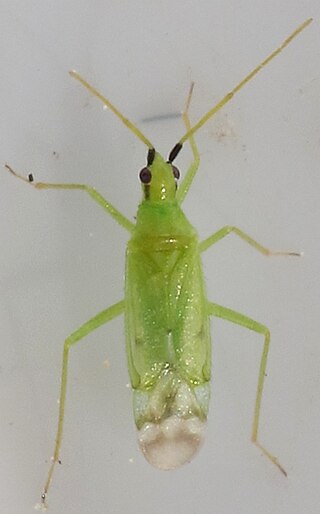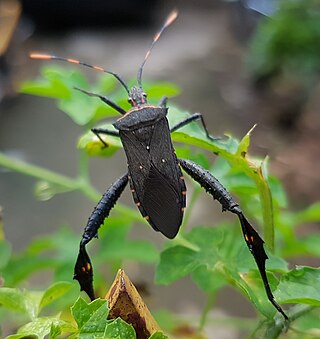Macrolophus caliginosus is a species of true bug in the family Miridae. It is omnivorous and both preys on insects and feeds on plant tissues. It is used in Europe in the biological control of whitefly in tomatoes grown under glass.

Macrolophus is a genus of plant bugs in the family Miridae. There are at least 20 described species in Macrolophus.

Neurocolpus nubilus, the clouded plant bug, is a species of plant bug in the family Miridae. It is found in North America.
Pilophorus gracilis is a species of plant bug in the family Miridae. It is found in North America.
Irbisia pacifica, the Pacific grass bug, is a species of plant bug in the family Miridae. It is found in Central America and North America.

Hesperolabops gelastops, the cactus bug, is a species of plant bug in the family Miridae. It is found in Central America and North America.
Criocoris saliens, the salien plant bug, is a species of plant bug in the family Miridae. It is found in North America.
Plagiognathus obscurus, the obscure plant bug, is a species of plant bug in the family Miridae. It is found in North America and South America.

Macrolophus pygmaeus is a species of plant bug in the family Miridae. It is found in Europe except the high north, south to north Africa and east to Asia Minor then to Central Asia. This species is omnivorous, preying on Tuta absoluta eggs and larvae, Ephestia kuehniella eggs, Macrosiphum euphorbiae nymphs, and plants such as Vicia fava. When feeding on plants, M. pygmaeus consumes extrafloral nectar. Its varied diet has created interest in M. pygmaeus as a pest control insect for the prior mentioned species.
Pilophorus tibialis is a species of plant bug in the family Miridae. It is found in Central America and North America.
Brooksetta althaeae, the hollyhock plant bug, is a species of plant bug in the family Miridae. It is found in North America.
Plagiognathus maculipennis is a species of plant bug in the family Miridae. It is found in Central America and North America.

Largus succinctus, known generally as Largus bug, is a species of bordered plant bug in the family Largidae. Other common names include the bordered plant bug and red bug. It is found in North America.

Rhinacloa forticornis, the western plant bug, is a species of plant bug in the family Miridae. It is found in the Caribbean Sea, Central America, North America, Oceania, and South America.
Centrinites is a genus of flower weevils in the beetle family Curculionidae. There are about 19 described species in Centrinites.
Plagiognathus brunneus is a species of plant bug in the family Miridae. It is found in North America.
Plagiognathus albatus is a species of plant bug in the family Miridae. It is found in North America.
Creontiades signatus, the verde plant bug, is a species of plant bug in the family Miridae. It is found in Central America and North America.
Macrolophus tenuicornis is a species of plant bug in the family Miridae. It is found in North America.

Leptoglossus gonagra, known as the passionvine bug, citron bug or squash bug in different parts of its range, is a species of leaf-footed bug in the family Coreidae. It is found in Africa, the Caribbean, Central America, North America, South America, Southern Asia, the Pacific Ocean and Oceania.






